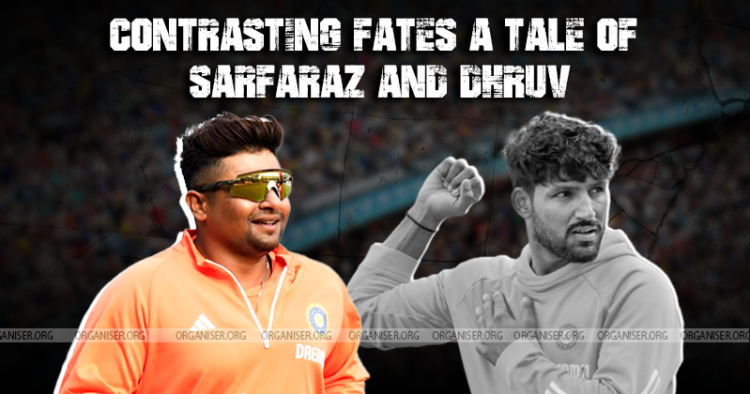Over the past two weeks, there has been a conspicuous media blitz surrounding a 26-year-old cricketer, painting a picture of special treatment within the realm of cricketing circles. Not only has this player been hyped up before the start of matches, but during his debut match, there have been repeated instances of showcasing his father and wife in the pavilion.
What’s more, the extent of this hype reached such heights that not only was his father brought into the commentary box for a formal interview, but even Anand Mahindra gifted him a luxury car. This extravagant treatment seems disproportionate considering the player’s debut score of 61 runs, despite the fact that he could have scored a century, had it not been for Jadeja’s mistake in his run out.
Furthermore, he managed to score 50 not out in the second innings. Until now, out of the 310 players who debuted in Test cricket, how many of their fathers have you seen interviewed in the commentary box? The answer is ‘zero’. How many of them have received a gift like Anand Mahindra presented him in such an early stage of his career? The answer is ‘zero’.
In the same match, another debutant Dhruv Jurel, whose father participated in the Kargil War, faced dire financial circumstances, forcing his mother to pawn her jewellery to afford his kit. He also scored 46 runs. However, there was no hype, no PR, no interview of his father in the commentary box, and certainly no gift. However, after a match-winning knock in the 4th test, Morris Garages (MG) India decided to gift Dhrur Jurel an MG Hector car as a token of appreciation for his achievement.
In the 4th test match, when the entire team was struggling to make significant runs, it was Yashasvi Jaiswal and Dhruv Jurel who emerged as the saviours, scoring crucial 73 and 90, respectively. Despite their pivotal contributions, they received far less attention compared to Sarfaraz Khan. Jurel’s resilience was once again evident in the second innings, where he formed a vital partnership with Shubman Gill, helping India secure a lead of 3-1 in the ongoing series by successfully chasing down a modest target of 192.
Think about it, how many people are aware of the name of Dhruv Jurel’s father, who was a part of the Kargil war?
However, Sarfaraz Khan, who was much hyped after his debut test match, faced criticism from netizens for his reluctant shots, resulting in dismissals for just 14 runs and a duck in both innings, respectively. Despite the anticipation surrounding his performance, Sarfaraz failed to deliver, leading to disappointment among fans and observers alike.
Unlike Sarfaraz, Dhruv received appreciation solely from Virender Sehwag, who remarked, “No media hype, no drama, just some outstanding skills and quietly showed great temperament in a very difficult situation. Very Well done Dhruv Jurel. Best wishes.” Sehwag’s acknowledgement highlighted Dhruv’s remarkable composure and skill in navigating challenging circumstances without seeking attention or drama.
Sehwag also commented on the performance of Kuldeep Yadav and said, “When it comes to hype, one of the least hyped guys is Kuldeep Yadav. Been exceptional for many years, but never got a online fan club or people to hype him as the next big thing. Deserves a lot more credit and hype than he gets”.
Now, consider the stark contrast in treatment between Sarfaraz Khan and Yashasvi Jaiswal. 22-year-old Yashasvi Jaiswal smashed back-to-back double centuries in this series, becoming the third Indian player to achieve such huge feat. Moreover, he broke Rohit Sharma’s world record for hitting the most sixes in a Test series.
Despite this remarkable performance, he is unlikely to receive as much attention. The media circus and PR machinery will not emphasise the journey of a boy who once sold ‘panipuri’ to reach this level of success.
Another debutant, Akash Deep, who took 3 crucial wickets in the first innings of the 4th test, was nowhere in the media. This bias is a testament to the power of PR, which outweighs the achievements of a player like Sarfaraz, who scored 61 runs, or Yashasvi’s double centuries and records. It reflects a narrow-minded mentality where decisions are made based on names and communities rather than talent and accomplishments.
According to the biased mentality of these narrow-minded individuals, Sarfaraz’s 61 runs inning was secular because he hails from a specific community, while Yashasvi’s double centuries were communal because his father carries out a religious practice and does not cry in front of the public.
Notably, Sarfaraz himself opened up on his India snub on more than one occasion. The 26-year-old revealed that he was upset after not earning an India call-up yet and even disclosed the conversation he had with BCCI chief selector Chetan Sharma and his promise of giving Sarfaraz a call-up for the Bangladesh tour last year.
The case of Sarfaraz highlights a common dilemma faced by many talented cricketers who toil in domestic circuits for years without clamouring for media attention or special treatment. Players like Amol Mazumdar serve as exemplary figures who dedicated decades to domestic cricket, amassing thousands of runs without employing PR tactics when not selected for the national team. Cricket, as a gentleman’s sport, should be played in the spirit of fair competition and integrity, without compromising on the dignity of the game.
Sarfaraz could benefit from Mazumdar’s approach by focusing on his game and letting his performance speak for itself, rather than seeking validation through media hype or special treatment.
It is to be noted that, former Mumbai captain Milind Rege reckons that Sarfaraz Khan’s job should be to score runs and perform, rather than expressing his disappointment on public platforms.
However, it’s evident that talent emerges from struggle and dedication, not from PR stunts. Yashasvi and Dhruv will continue to excel because they possess a fire within them, a drive fuelled by hard work and not by PR agencies.
While praising a player is a commendable practice, creating excessive hype around them is detrimental. This could lead to adverse effects on their performance as they might become overconfident. Subsequently, if they fail to deliver, the same media that hyped him up will be quick to criticise and demand their removal from the team. Therefore, manufacturing hype is not beneficial in the long-run as it can have a negative impact on the player’s confidence and performance. It’s essential to strike a balance and allow players to grow and perform without undue pressure or unrealistic expectations imposed by media hype.
In conclusion, it’s essential to recognise and celebrate talent irrespective of backgrounds and affiliations. The cricketing world should focus on nurturing genuine talent rather than succumbing to the influence of media hype and PR machinery. Only then can we truly appreciate the spirit of the sport and the efforts of its players.




















Comments